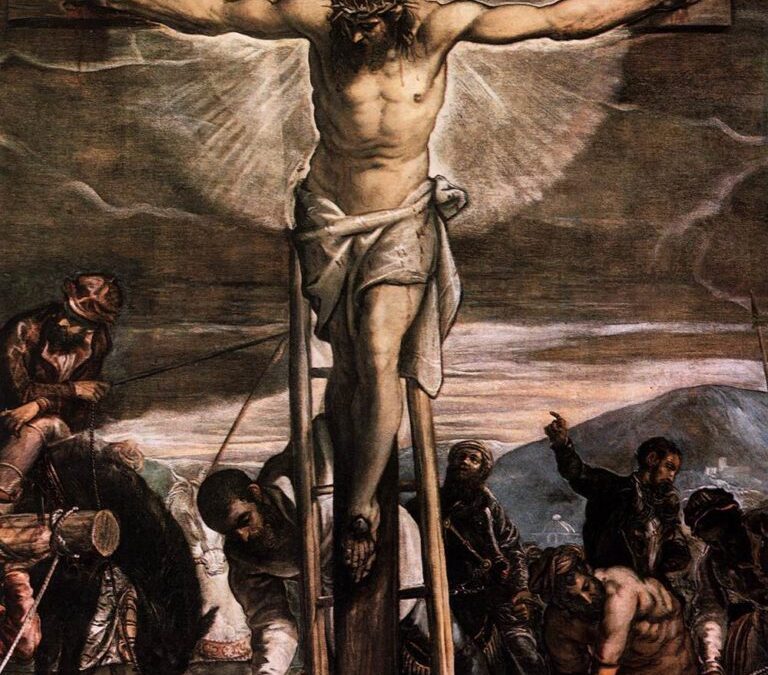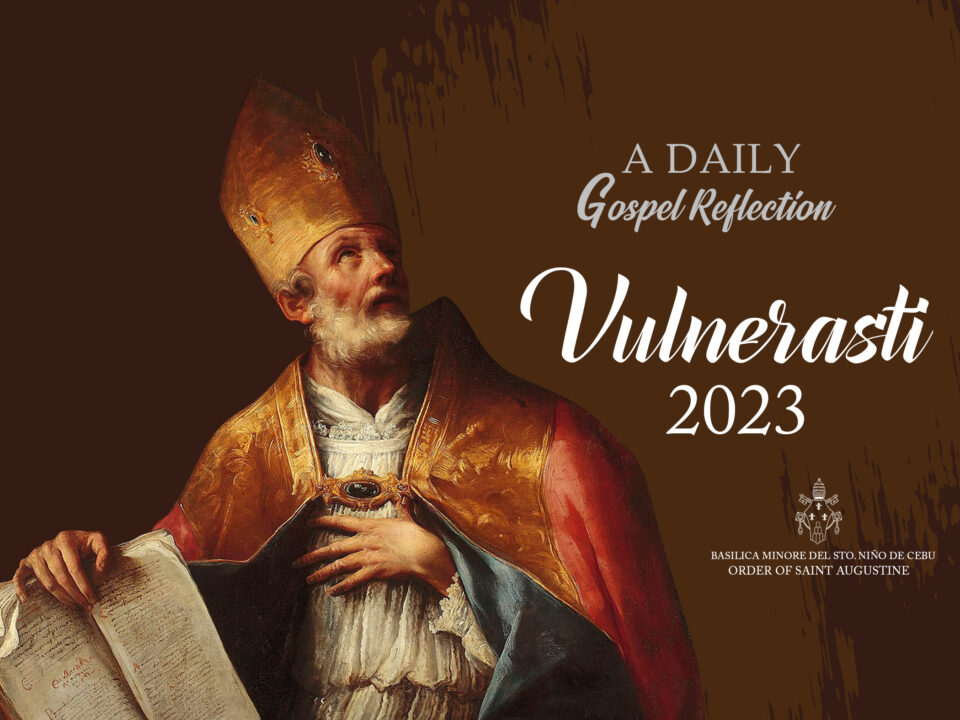Good Friday of the Lord’s Passion

https://www.newemangelization.com/meeting-jesus/catholic-mens-daily-devotional-and-bible-study-holy-week-friday-the-passion-of-our-lord-john-181-1942/
Today’s Reflection
Gospel: John 18:1-19:42
April 15, 2022 | Friday
The Passion of our Lord Jesus Christ according to John.
When Jesus had finished speaking, he went with his disciples to the other side of the Kidron Valley. There was a garden there. Which Jesus entered with his disciples.
Now Judas, who betrayed him, knew the place, since Jesus had often met there with his disciples. So Judas took soldiers and some servants from the chief priests and Pharisees, and they went to the garden with lanterns, torches and weapons.
Jesus knew all that was going to happen to him; he stepped forward and asked, “Who are you looking for?” They answered, “Jesus the Nazarene.” Jesus said, “I am he.” Judas, who betrayed him, stood there with them.
When Jesus said, “I am he,” they moved backwards and fell to the ground. He then asked a second time, “Who are you looking for?” and they answered, “Jesus the Nazarene.” Jesus replied, “I told you that I am he. If you are looking for me, let these others go. ”So what Jesus had said came true: “I have not lost one of those you gave me.”
Simon Peter had a sword; he drew it and struck Malchus, the High Priest’s servant, cutting off his right ear. But Jesus said to Peter, “Put your sword into its sheath! Shall I not drink the cup which the Father has given me?”
The guards and the soldiers, with their commander, seized Jesus and bound him; and they took him first to Annas. Annas was the father-in-law of Caiaphas, who was the High Priest that year; and it was Caiaphas who had told the Jews, “It is better that one man should die for the people.”
Simon Peter and another disciple followed Jesus. Because this disciple was known to the High Priest, they let him enter the courtyard of the High Priest along with Jesus, but Peter had to stay outside at the door. The other disciple, who was known to the High Priest, went out and spoke to the maidservant at the gate and brought Peter in. Then this maidservant on duty at the door said to Peter, “So you also are one of his disciples?” But he answered, “I am not.”
Now the servants and the guards had made a charcoal fire and were standing and warming themselves, because it was cold. Peter was also with them warming himself.
The High Priest questioned Jesus about his disciples and his teaching. Jesus answered him, “I have spoken openly to the world; I have always taught in places where the Jews meet together, either at the assemblies in synagogues or in the temple. I did not teach secretly. Why then do you question me? Ask those who heard me, they know what I said.”
At this reply one of the guards standing there gave Jesus a blow on the face, saying, “Is that the way to answer the High Priest?” Jesus said to him, “If I have said something wrong, point it out. But if I spoke correctly, why strike me?”
Then Annas sent him, bound, to Caiaphas, the High Priest.
Now Simon Peter stood there warming himself. They said to him, “Surely you also are one of his disciples.” He denied it, and answered, “I am not!” One of the High Priest’s servants, a kinsman of the one whose ear Peter had cut off, asked, “Did I not see you with him in the garden?” Again Peter denied it, and at once the cock crowed.
Then they led Jesus from the house of Caiaphas to the headquarters of the Roman governor. It was now morning. The Jews didn’t go inside, lest they be made unclean by entering the house of a pagan, and therefore not allowed to eat the Passover meal. So Pilate came outside and asked, “What charge do you bring against this man?”
They answered, “If he were not a criminal, we would not be handing him over to you.” Pilate said, “Take him yourselves and judge him according to your own law.” But they replied, “We ourselves are not allowed to put anyone to death.”
According to what Jesus himself had foretold, it was clear what kind of death he would die.
Pilate then entered the court again, summoned Jesus and asked him, “Are you the King of the Jews?” Jesus replied, “Are you saying this on your own initiative; or have others told you about me?”
Pilate answered, “Am I a Jew? Your own nation and the chief priests have handed you over to me. What have you done?” Jesus answered, “My kingship does not come from this world. If I were a king, like those of this world, my servants would have fought to save me from being handed over to the Jews. But my kingship is not of this world.”
Pilate asked him, “So you are a king?” And Jesus answered, “Just as you say, I am a king. For this I was born and for this I have come into the world, to bear witness to the truth. Everyone who is on the side of truth hears my voice.” Pilate said, “What is truth?”
Pilate then went out to the Jews again and said, “I find no crime in this man. Now, according to custom, I must release a prisoner to you at the Passover. With your agreement I will release to you the king of the Jews.” But they insisted and cried out, “Not this man, but Barabbas!” Now Barabbas was a robber.
Then Pilate had Jesus taken away and scourged. The soldiers twisted thorns into a crown and put it on his head. They threw a cloak of royal purple around his shoulders; and they began coming up to him and saluting him, “Hail, King of the Jews!” and they struck him on the face.
Pilate went outside yet another time and said to the Jews, “Look, I am bringing him out, and I want you to know that I find no crime in him.” Jesus then came out wearing the crown of thorns and the purple cloak, and Pilate pointed at him, saying, “Behold the man!”
On seeing him the chief priests and the guards cried out, “Crucify him! Crucify him!” Pilate said, “Take him yourselves and have him crucified, for I find no case against him.” The Jews then said, “We have a Law, and according to the Law this man must die because he made himself Son of God.”
When Pilate heard this he was more afraid. And coming back into the court he asked Jesus, “Where are you from?” But Jesus gave him no answer. Then Pilate said to him, “You will not speak to me? Do you not know that I have power to release you, just as I have power to crucify you?” Jesus replied, “You would have no power over me unless it had been given to you from above; therefore the one who handed me over to you is more guilty.”
From that moment Pilate tried to release him, but the Jews cried out, “If you release this man, you are no friend of Caesar. Anyone who makes himself a king is defying Caesar.”
When Pilate heard this, he had Jesus brought outside to the place called the Stone Floor—in Hebrew Gabbatha—and sat down in the judgment seat. It was the day of preparation for the Passover, about noon. Pilate said to the Jews, “Behold your king!” But they cried out, “Away! Take him away! Crucify him!” Pilate replied, “Shall I crucify your king?” And the chief priests answered, “We have no king but Caesar!”
Then Pilate handed Jesus over to them to be crucified.
They took Jesus, and led him away. Bearing his cross, Jesus went out of the city to what is called the Place of the Skull, in Hebrew Golgotha. There he was crucified, and with him two others, one on either side, and Jesus in the middle.
Pilate had a notice written and fastened to the cross, which read: Jesus the Nazarene, the king of the Jews. Many Jewish people saw this title, because the place where Jesus was crucified was very close to the city; and the title was written in Hebrew, Latin and Greek. The chief priests said to Pilate, “Do not write ‘The King of the Jews’; but, ‘This man claimed to be King of the Jews.’” Pilate answered them, “What I have written, I have written.”
When the soldiers crucified Jesus, they took his clothes and divided them into four parts, one part for each of them. But as the tunic was woven in one piece from top to bottom, they said, “Let us not tear it, but cast lots to decide who will get it.” This fulfilled the words of Scripture: They divided my clothing among them; they cast lots for my garment. This was what the soldiers did.
Near the cross of Jesus stood his mother, his mother’s sister Mary, who was the wife of Cleophas, and Mary of Magdala. When Jesus saw the mother, and the disciple whom he loved, he said to the mother, “Woman, this is your son.” Then he said to the disciple, “This is your mother.” And from that moment the disciple took her to his own home.
Jesus knew all was now finished and, in order to fulfill what was written in Scripture, he said, I am thirsty. A jar full of bitter wine stood there; so, putting a sponge soaked in the wine on a twig of hyssop, they raised it to his lips. Jesus took the wine and said, “It is accomplished.” Then he bowed his head and gave up the spirit.
As it was Preparation Day, the Jews did not want the bodies to remain on the cross during the Sabbath, for this Sabbath was a very solemn day. They asked Pilate to have the legs of the condemned men broken, so that the bodies might be taken away.
The soldiers came and broke the legs of the first man and of the other man, who had been crucified with Jesus. When they came to Jesus, they saw that he was already dead, so they did not break his legs. One of the soldiers, however, pierced his side with a lance, and immediately there came out blood and water.
The one who saw that, has testified to it, and his testimony is true; he knows he speaks the truth, so that you also might believe. All this happened to fulfill the words of Scripture: Not one of his bones shall be broken. Another text says: They shall look on him whom they have pierced.
After this, Joseph of Arimathea approached Pilate, for he was a disciple of Jesus, though secretly, for fear of the Jews. And he asked Pilate to let him remove the body of Jesus. Pilate agreed, so he came and took away the body.
Nicodemus, the man who first visited Jesus by night, also came and brought a jar of myrrh mixed with aloes, about seventy-five pounds. They took the body of Jesus and wrapped it in linen cloths with the spices, following the burial customs of the Jews.
There was a garden in the place where Jesus had been crucified, and, in the garden, a new tomb in which no one had ever been laid. And therefore, because the sepulcher was nearby, and the Jewish day of preparation was coming to a close, they placed the body of Jesus there.
Today’s Reflection:
“The truth will make you free” (8:32b) is perhaps the most remembered statement of Jesus in the Gospel of John. The meaning of this statement is to some extent dealt with in the Passion Narrative, particularly in the exchanges between Jesus and Pontius Pilate. Having equated himself with the truth (cf. 14:6), Jesus declares during his trial before Pilate that he comes to bear witness to the truth and that whoever belongs “to the truth” listens to him (18:37). In response, Pilate asks a famous question: “What is ‘truth’?” (18:38a).
There is a subtle but striking disconnect between Jesus’ statements and Pilate’s question. While Jesus speaks of “the truth” (ἡ ἀλήθεια) in the definitive sense, Pilate asks about “truth” (ἀλήθεια) in an indefinite sense. Whereas the former speaks of the ultimate truth who is no other than God (cf. 8:58), the latter asks about truth in general.
Pilate’s question represents his wavering commitment to finding and upholding the truth. After a thorough investigation, Pilate finds out that Jesus is not a threat to the Roman Empire. He pronounces him as innocent of the charges against him no less than three times (18:38; 19:4, 6). As the Roman governor of Palestine at that time, he has absolute control and power over this subjugated territory as indicated in what he tells Jesus: “Do you not know that I have power to release you, and power to crucify you?” (19:10). Yet he quickly accedes to the demands of the crowd to get rid of Jesus. As a quick fix to the noises of the maddening crowd, he has Jesus crucified—the most painful and shameful means of capital punishment meted out by Rome to the most dangerous destabilizers.
Jesus’ statements, on the other hand, reveal his truthfulness to his identity as the embodiment (incarnation) of God. He remains unwavering in his statements that he is indeed God and that he is indeed a king in the kingdom that is not of this world. Throughout his unjust trial and eventual crucifixion, Jesus remains calm and unafraid despite being betrayed by his own people and denied thrice by his closest and most trusted disciple (18:17, 25, 27).
The Lord’s steadfast and fearless fidelity to the truth has a gracious and liberating effect not just o, his frightened followers but even on his enemies. His resurrection proves that every word he spoke and every truth-claim he made is true. So gracious and liberating is his enduring commitment to the truth that even Pilate’s sarcastic inscription on the cross gets gradually transformed into a powerful testament on the Lord’s universal kingship. The said inscription—Jesus of Nazareth, the King of the Jews—written in Hebrew (or Aramaic), Greek, and Latin (the spoken languages in Palestine at that time) was originally meant to make the charges against him known. Ironically, it has come to be taken as a sort of “bumper sticker” proclaiming the Lord’s Universal Reign.
The Lord’s commitment to the truth serves us our ideal. In reality, however, most of us identify with Pilate as far as our commitment to knowing and standing for the truth is concerned. Not only do we often fail to differentiate facts from propagandas, but we also tend to compromise the truth in exchange for some favors. However frail our commitment to the truth may be, the Lord constantly exhorts us to seek and stand for it. It is hoped that we shall soon become profoundly secure of ourselves and capable of standing for the truth no matter how high the cost may be. Let us draw inspiration from the Resurrected Lord. His steadfast stand for the truth has inspired the early Christians to overcome all sorts of persecutions and sufferings in their proclamation of the Gospel in the wider expanse of the hostile Roman Empire. /Vulnerasti, 2022



